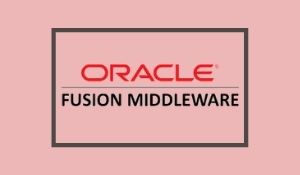
WHAT IS ORACLE FUSION MIDDLEWARE?
Oracle Fusion Middleware is a collection of standards-based software products that spans a range of tools and services: from Java EE and developer tools to integration services, identity management, business intelligence, and collaboration. Oracle Fusion Middleware offers complete support for development, deployment, and management. In layman terms, anything that is not an Operating System or Database or ERP/CRM like Fusion Applications, E-Business Suite, Siebel, PeopleSoft, JD Edward, etc is Oracle Fusion Middleware.
Products that are part of Oracle Fusion Middleware include:
- Oracle WebLogic Server
- Web Tier (OHS & OTD)
- Oracle SOA Suite
- Oracle Business Intelligence Enterprise Edition (OBIEE)
- Oracle WebCenter Suite (Portal & Content)
- Oracle Data Integrator (ODI)
- Oracle Identity & Access Management (OAM, OID, OUD, OIG, OVD, etc)
Specifically, middleware is the software that connects software components or organization applications. Middleware is the software layer that lies between the operating device and the applications on each aspect of a distributed computer network. Typically, middleware supports complex, disbursed business software applications.

Middleware is also the infrastructure that allows the creation of enterprise applications, and offers core services like concurrency, transactions, threading, messaging, and the SCA framework for service-oriented architecture (SOA) applications. It additionally gives security and allows high availability functionality to your enterprise. Middleware consists of Web servers, application servers, content management systems, and similar tools that support application development and delivery. It is mainly integral to information technology based on Extensible Markup Language (XML), Simple Object Access Protocol (SOAP), Web services, SOA, Unicode, Web 2 infrastructure, and Lightweight Directory Access Protocol (LDAP). Textual data is represented in the Unicode character set to guide data exchange in any language. UTF-8 is used as the standard encoding for transporting data for the most desirable compatibility and efficiency, while traditional non-Unicode encodings can additionally be used where supported.
LATEST VERSIONS AND ITS OPPORTUNITIES
Oracle Fusion Middleware 12c (12.1.2) consists of the following new and changed concepts and features from preceding Oracle Fusion Middleware releases:
- Middleware topology changes.
- OPMN is no longer used in Oracle Fusion Middleware. Instead, system components are managed via the WebLogic Management Framework.
- Redefining of the Oracle home and removal of the Middleware home.
- Support for a “per domain” Node Manager.
- Oracle Web Cache is no longer part of Oracle Fusion Middleware.

SOA Suite is used as business application integrations both on-premise or cloud-based applications. Thousands of organizations are building Business Applications using Oracle Fusion Middleware stack be it WebCenter Portal for exhibiting content, BPMS/SOA for business process, OBIEE for Intelligence, or WebCenter for content management. Oracle’s Fusion Applications like E-Business Suite, PeopleSoft, Siebel, JD Edward are built on top of Oracle Fusion Middleware. It has a market share of about 8.5%. Looking at Oracle Fusion Middleware customers through the industry, we find that Computer Software (24%) and Information Technology and Services (14%) are the biggest segments. Today there are lots of suitable Jobs, Boost your career with these excellent Oracle Fusion Middleware online training that helps you to expertise as well as get you a good job in a multinational company.











